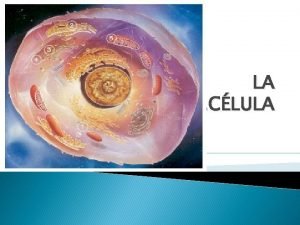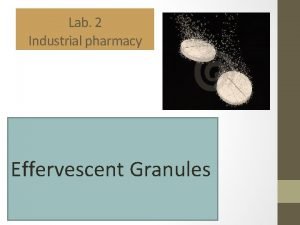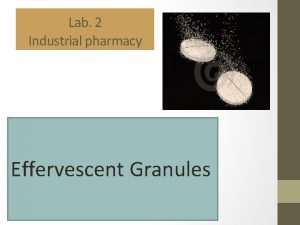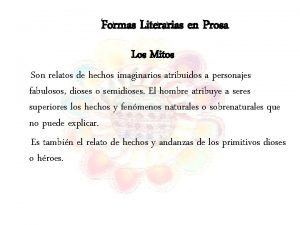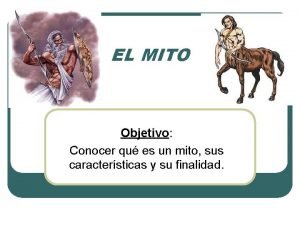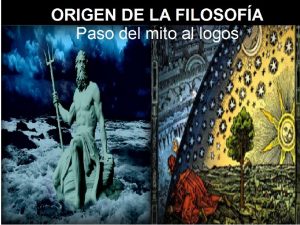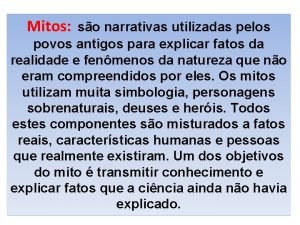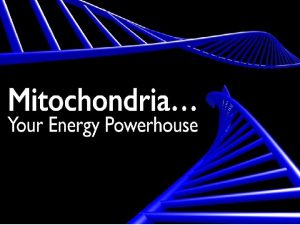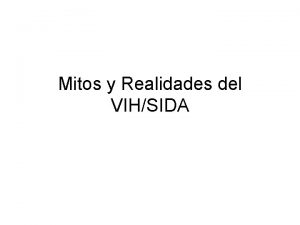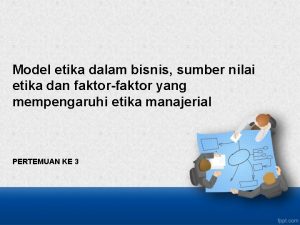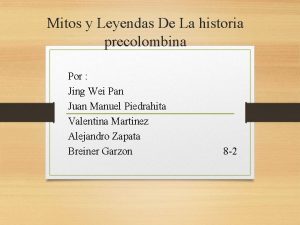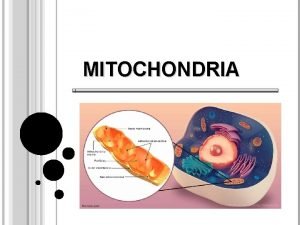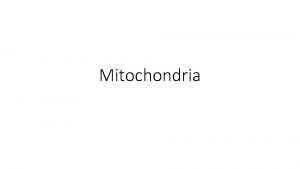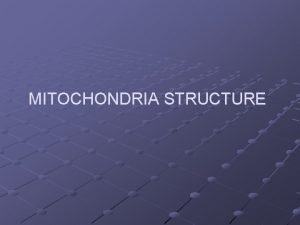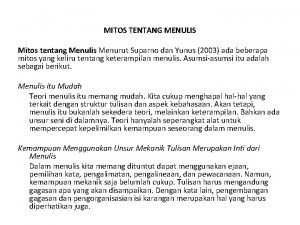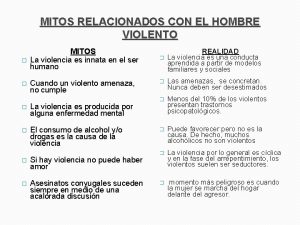MITOCHONDRIA Mitochondria Mitos Thread Chondrion Granule History Kolliker





















- Slides: 21

MITOCHONDRIA Mitochondria Mitos: Thread Chondrion: Granule .

History: • Kolliker (1880) first observed it as cytoplasmic • • • granules in striped muscles of insects. Altman (1894) established them as cell organelles and called Bioblast. Flemming & Altman was credited for its discovery. Term 'Mitochondria' was given by C. Benda. F. Meves (1904) first observed them in plants (Nymphea). Kinsberg & Hogeboom (1948) related them with cell respiration. Seikevitz called them power house of cell.

Mitochondria

• Small granular, filamentous bodies of cytoplasm • Found in all aerobically respiring cells • Contain enzymes and co-enzymes responsible for energy metabolism. • Closely related with cellular respiration • Membrane-enclosed organelle found in most eukaryotic cells. • These organelles range from 0. 5 to 1. 0 μ m in diameter. • (15000 Aº long & 5000 Aº wide) • Mitochondria are sometimes described as "cellular power plants" because they generate most of the cell's supply of adenosine triphosphate (ATP), used as a source of chemical energy.

• • • Shape: Filamentous granular May change became rod, club, ring etc. Size: 3 -10 μ m and 0. 5 -1 μ m diameter Smallest- 1 μ m in yeast Largest- 20 -30 μ m in oocytes of amphibians p. H, cell environment, osmotic pressure related to the shape and size Number of mitochondria: Varies, related to functional state of cell. Liver cell: 1000 -1600 Renal tubule: 300 -400 Sea urchin egg 13000 -14000 Human sperm- 25 Scattered in cytoplasm in most of cells

• In addition to supplying cellular energy, mitochondria are involved in a range of other processes, such as signaling, cellular differentiation, cell death, as well as the control of the cell cycle and cell growth • Mitochondria have been implicated in several human diseases, including mitochondrial disorders and cardiac dysfunction and may play a role in the aging process.

• The number of mitochondria in a cell varies widely by organism and tissue type. • Many cells have only a single mitochondrion, whereas others can contain several thousand mitochondria • The organelle is composed of compartments that carry out specialized functions. • These compartments or regions include the outer membrane, the intermembrane space, the inner membrane, and the cristae and matrix.

Structure • A mitochondrion contains outer and inner membranes composed of phospholipid bilayers and proteins • The two membranes, however, have different properties. • Because of this double membrane organization, there are five distinct compartments within the mitochondrion. • There is the 1. outer mitochondrial membrane, 2. The intermembrane space (the space between the Outer and inner membranes), 3. The inner mitochondrial membrane, 4. The cristae space (formed by infoldings of the inner membrane), and 5. The matrix (space within the inner membrane).

Internal structure of a mitochondrion

Outer membrane • The outer mitochondrial membrane, which encloses the entire organelle, has a protein-to-phospholipid ratio similar to that of the eukaryotic plasma membrane • Each membrane about 60 Aº in thickness • It contains large numbers of integral proteins called porins. • These porins form channels that allow molecules 5000 Daltons or less in molecular weight to freely diffuse from one side of the membrane to the other.

• Intermembrane space: • The intermembrane space (60 -80 Aº) is the space between the outer membrane and the inner membrane. • Because the outer membrane is freely permeable to small molecules • One protein that is localized to the intermembrane space in this way is cytochrome c

• Inner membrane • The inner mitochondrial membrane contains proteins with five types of functions. 1) Those that perform the redox reactions of oxidative phosphorylation 2) ATP syntheses, which generates ATP in the matrix 3) Specific transport proteins that regulate metabolite passage into and out of the matrix 4) Protein import machinery. 5) Mitochondria fusion and fission protein

Cristae: • The inner mitochondrial membrane is compartmentalized into numerous cristae, which expand the surface area of the inner mitochondrial membrane, enhancing its ability to produce ATP. • For typical liver mitochondria the area of the inner membrane is about five times greater than the outer membrane. • This ratio is variable and mitochondria from cells that have a greater demand for ATP, such as muscle cells, contain even more cristae. • • These folds are studded with small round bodies known as F 1 particles or oxysomes. .

Elementary particle/F 1 Particle/oxysomes/ETP • Outer membrane particles; 60 A⁰, stalk less • Inner membrane particles; 160 A⁰, with head, stalk & base (80 A⁰, 50 A⁰, 80 A⁰, )

Cross-sectional image of cristae in rat liver mitochondrion to demonstrate the likely 3 D structure and relationship to the inner membrane.

• Mitochondrial matrix: • The matrix is the space enclosed by the inner membrane. • It contains about 2/3 of the total protein in a mitochondrion. • The matrix is important in the production of ATP • The matrix contains a highly-concentrated mixture of hundreds of enzymes, special mitochondrial ribosome's, t. RNA, and several copies of the mitochondrial DNA genome. • Of the enzymes, the major functions include oxidation of pyruvate and fatty acids, and the citric acid cycle • Mitochondria have their own genetic material, and the machinery to manufacture their own RNAs and proteins.

Chemical composition of Mitochondrion • The mitochondrial memb. has chemical organization • Each memb. Is made up of proteins and lipids • Proteins 65 to 70%, insoluble in water • Lipids 25 -30% : composed of 90 % of phospholipids, 5 % cholesterol and 5 % free fatty acids • The molecule phospholipids is insoluble in water but structural group of phospholipids molecule called micelle is soluble • It also consists of 0. 5 % RNA, small amount of DNA, S, Fe, Cu and some Vitamins • The mitochondrial DNA is double stranded and circular • More than 70 enzymes and co enzymes in matrix of Mitochondrion

Functions: • The most prominent roles of mitochondria are to produce ATP (i. e. , phosphorylation of ADP) through respiration, and to regulate cellular metabolism • The central set of reactions involved in ATP production are collectively known as the citric acid cycle, or the Krebs Cycle. • However, the mitochondrion has many other functions in addition to the production of ATP.

STEPS IN CELL RESPIRATION: 1. GLYCOLYSIS: Breakdown of glucose to pyruvic acid Glucose + Cytoplasmic enzyme ………. . → Pyruvic acid 2. OXIDATION AND DECARBOXYLATION of PYRUVIC ACID : Pyruvic acid+ P. Acid Dehydrogenase enzyme of F 1 particle ……→ Acetyl Co. A+ 2 H++ CO 2↑ 3. KREBS CYCLE/ CITRIC ACID CYCLE: (1936) Acetyl Co. A+ Oxaloacetic acid, citric acid synthatase → Citric Acid with 6 carbon atom Succinyl Co. A →S. A. Thiokinase → Succcinic acid, synthesis of 1 mol. Of ATP 4. OXIDATIVE PHOSPHRYLATION ; The complete oxidation of 1 glucose molecule yields about 38 molecules of ATP C 6 H 12 O 6+ 6 O 2+ 6 H 2 O+38 ADP+38 IP → Respiratory enzymes → 6 CO 2+12 H 20+38 mol. ATP

2 -70 (Alberts): Cellular metabolism

Additional functions of mitochondria… 1. 2. 3. 4. 5. 6. Regulation of the membrane potential Apoptosis-programmed cell death Calcium signaling Cellular proliferation regulation Regulation of cellular metabolism Some mitochondrial functions are performed only in specific types of cells. ( For example, mitochondria in liver cells contain enzymes that allow them to detoxify ammonia, a waste product of protein metabolism. A mutation in the genes regulating any of these functions can result in mitochondrial diseases. )
 Kolliker mitocondrias
Kolliker mitocondrias Une pilule une petite granule chanson
Une pilule une petite granule chanson Granules pharmacy
Granules pharmacy Hongsamdan
Hongsamdan Granules in pharmacy
Granules in pharmacy Mombe'upy ka'a
Mombe'upy ka'a Mitos steg
Mitos steg Un mito
Un mito Mitos y logos ejemplos
Mitos y logos ejemplos El mito de cleopatra
El mito de cleopatra Mitos são narrativas utilizadas pelos povos gregos
Mitos são narrativas utilizadas pelos povos gregos Clases de mitos
Clases de mitos Tipos de mitos
Tipos de mitos Mitos puertorriqueños
Mitos puertorriqueños Cuáles son las características de las leyendas
Cuáles son las características de las leyendas Chondia
Chondia Mitos y realidades del vih
Mitos y realidades del vih Mitos bisnis amoral adalah
Mitos bisnis amoral adalah O que são mitos
O que são mitos Canciones basadas en leyendas
Canciones basadas en leyendas Model etika bisnis
Model etika bisnis Mito de bague.
Mito de bague.
